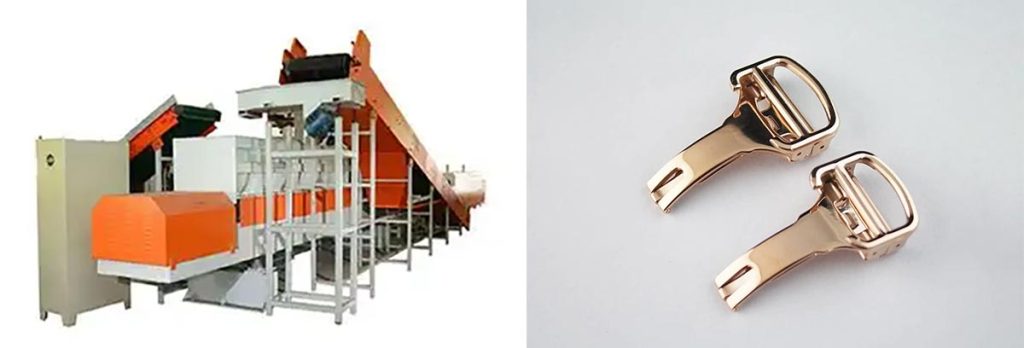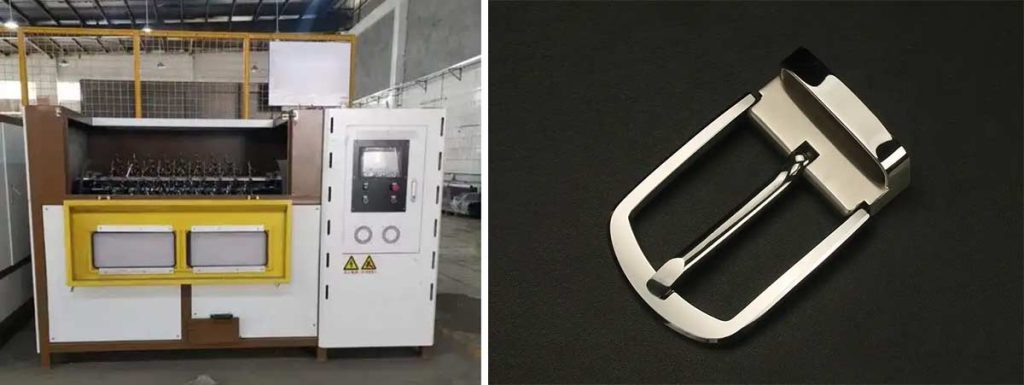

Nanotechnology has revolutionized the way industries approach metal polishing. By manipulating materials at the nanoscale, it enables unparalleled precision and efficiency in polishing processes. An industrial metal polishing machine equipped with nanotechnology delivers smoother finishes and reduces material waste. Automatic polishing machines now utilize advanced nanomaterials to enhance surface quality while minimizing energy consumption. This innovation not only improves productivity but also supports sustainable practices in industrial applications. As industries demand higher standards, nanotechnology continues to redefine the capabilities of modern polishing machines.
Key Takeaways
- Nanotechnology makes metal polishing better by increasing accuracy and speed.
- Machines with nanomaterials give smoother surfaces and use less energy.
- Abrasives with nanoparticles create very smooth finishes for cars and planes.
- Special nanocoatings keep metals safe from rust and dirt, lasting longer.
- AI and nanotechnology together improve polishing, cut waste, and help the environment.
Nanotechnology in Industrial Metal Polishing Machine
Defining Nanotechnology in the Context of Metal Polishing
Nanotechnology involves manipulating materials at the atomic and molecular levels, typically within the range of 1 to 100 nanometers. In the context of an industrial metal polishing machine, this technology enables the creation of tools and materials with enhanced properties. These include improved hardness, precision, and resistance to wear. By integrating nanotechnology, manufacturers can achieve ultra-smooth surfaces that meet the stringent requirements of modern industries. This approach also supports eco-friendly innovations by reducing waste and energy consumption during polishing processes.
Key Advantages of Nanotechnology for Polishing Processes
Nanotechnology offers several advantages for polishing processes. First, it enhances the efficiency of an automatic polishing machine by enabling faster and more precise operations. Second, it contributes to sustainable manufacturing by minimizing material waste and energy usage. Third, the use of nanomaterials ensures superior surface finishes, which are critical in industries like aerospace, automotive, and electronics. Additionally, nanotechnology promotes eco-friendly practices by reducing the environmental impact of polishing agents. These benefits make it a cornerstone of modern industrial applications.
The Role of Nanomaterials in Industrial Applications
Nanomaterials play a pivotal role in the functionality of an industrial metal polishing machine. These materials, such as nanoparticle-infused abrasives, provide exceptional durability and performance. They enable machines to polish surfaces with greater accuracy, resulting in consistent and high-quality finishes. Furthermore, nanomaterials contribute to eco-friendly innovations by replacing traditional, harmful chemicals with safer alternatives. Their application extends beyond polishing, influencing sustainable manufacturing practices and reducing the overall environmental footprint of industrial processes.
Applications of Nanotechnology in Metal Polishing
Nanoparticle-Infused Abrasives for Superior Finishes
Nanoparticle-infused abrasives have transformed the polishing process in industrial applications. These abrasives contain nanoparticles that enhance the cutting and smoothing capabilities of polishing tools. By using these advanced materials, an industrial metal polishing machine can achieve ultra-smooth finishes with minimal effort. The nanoparticles ensure uniform abrasion, reducing the risk of surface imperfections. This innovation is particularly beneficial in industries like aerospace and automotive, where precision and surface quality are critical. Additionally, nanoparticle-infused abrasives improve the efficiency of an automatic polishing machine by reducing the time required for polishing tasks.
Advanced Surface Coatings for Durability

Nanotechnology has enabled the development of advanced surface coatings that significantly enhance the durability of polished metals. These coatings form a protective layer on the metal surface, offering multiple benefits. The table below highlights the advantages of these nanocoatings:
| Benefit | Description |
|---|---|
| Enhanced Protection | The nanocoating forms a protective layer on the metal surface, shielding it from oxidation, corrosion, and water damage. |
| Water Repellency | The nanotechnology creates a hydrophobic barrier, preventing water from penetrating the metal surface. |
| Improved Longevity | By providing a protective barrier, the nanocoating helps to extend the lifespan of the metal surface. |
| Dirt and Contaminant Resistance | The nanocoating’s repellent properties also prevent the build-up of dirt, dust, and other contaminants on the metal surface. |
| UV Stability | The nanocoating offers excellent UV stability, protecting the metal surface from the harmful effects of sunlight and UV radiation. |
Industries such as energy, aerospace, automotive, and medical have successfully adopted these coatings. For example, hydrophobic coatings reduce maintenance on aircraft, while hydrophilic coatings improve the performance of solar panels. These applications demonstrate the versatility of nanotechnology in enhancing durability across various industrial sectors.
Precision Enhancements in Polishing Techniques
Nanotechnology has introduced precision enhancements that elevate the performance of polishing techniques. By incorporating nanomaterials, an industrial metal polishing machine can achieve unparalleled accuracy. These machines can now polish intricate designs and complex geometries with ease. The nanoscale properties of the materials allow for controlled abrasion, ensuring consistent results. This level of precision is essential in industries like electronics, where even minor imperfections can affect functionality. Furthermore, the integration of nanotechnology into an automatic polishing machine reduces human error, making the process more reliable and efficient.
Self-Cleaning and Anti-Corrosion Features in Polished Metals
Nanotechnology has introduced groundbreaking self-cleaning and anti-corrosion features to polished metals, transforming their performance in industrial applications. These advancements rely on specialized nanocoatings that enhance the surface properties of metals, making them more durable and easier to maintain.
Self-cleaning capabilities stem from the hydrophobic barriers created by nanocoatings. These barriers repel water and prevent dirt, dust, and other contaminants from adhering to the surface. As a result, polished metals stay cleaner for longer periods, reducing the need for frequent maintenance. This feature proves especially valuable in industries like construction and automotive, where maintaining pristine surfaces is critical.
Anti-corrosion properties arise from the protective layers formed by nanocoatings. These layers shield metals from oxidation and environmental damage, significantly extending their lifespan. For example, in marine and aerospace industries, where exposure to harsh conditions is common, these coatings help prevent rust and degradation. Additionally, the UV stability of nanocoatings protects metals from sunlight-induced wear, ensuring long-term durability.
The table below summarizes the mechanisms behind these features:
| Mechanism | Description |
|---|---|
| Protective Barrier | The nanocoating forms a protective layer on the metal surface, shielding it from oxidation and corrosion. |
| Hydrophobic Barrier | It creates a hydrophobic barrier, preventing water from penetrating the metal surface, minimizing water damage. |
| UV Stability | The nanocoating offers excellent UV stability, protecting the metal from harmful effects of sunlight. |
| Dirt and Contaminant Repellence | The coating prevents the build-up of dirt, dust, and other contaminants, keeping the metal clean longer. |
| Longevity and Durability | By reducing oxidation and corrosion risks, the nanocoating extends the lifespan of the metal surface. |
An automatic polishing machine equipped with nanotechnology applies these coatings with precision, ensuring consistent results across various industrial settings. These innovations not only improve the functionality of polished metals but also contribute to sustainable practices by reducing maintenance and material waste.
Future Trends in Nanotechnology for Metal Polishing
AI Integration with Nanotechnology in Automatic Polishing Machines
Artificial intelligence (AI) is transforming the automatic polishing machine market by combining with nanotechnology to create smarter, more efficient systems. AI-driven process optimization allows machines to analyze surface conditions in real time and adjust polishing parameters accordingly. This ensures consistent results while reducing material waste. Real-time monitoring with IoT sensors further enhances this capability by providing detailed feedback on machine performance.
Hybrid polishing machines equipped with AI and nanotechnology offer energy-efficient designs that minimize power consumption. These machines use predictive maintenance and optimization to identify potential issues before they occur, reducing downtime and repair costs. By integrating AI, manufacturers can achieve zero-waste manufacturing goals, aligning with eco-friendly innovations in the industrial sector.
Development of Biodegradable and Non-Toxic Polishing Agents
The shift toward biodegradable and non-toxic polishing agents represents a significant step in eco-friendly innovations. These agents reduce harmful emissions by preventing the release of volatile organic compounds (VOCs) into the environment. This aligns with global environmental standards and supports sustainable practices in the automatic polishing machine market.
Biodegradable agents also enhance recycling and reuse of by-products, contributing to a circular economy. Their adoption reduces the environmental impact of industrial processes while maintaining high polishing performance. Research into sustainable alternatives, such as plant-based abrasives, further supports this trend. These materials replace traditional chemicals, promoting safer and more eco-friendly practices.
Smart Polishing Machines with Nanotechnology
Smart polishing machines are redefining the industrial metal polishing machine landscape. These advanced systems incorporate nanotechnology to achieve precision finishing and lower energy consumption. Hybrid polishing machines with energy-efficient designs use nanotechnology-based polishes to deliver superior surface quality. Water-based polishes, another innovation, enhance sustainability by reducing the reliance on harmful chemicals.
These machines also support zero-waste manufacturing goals by optimizing material usage. Their ability to create self-cleaning substrates and corrosion-resistant surfaces adds value across various industries. As research into sustainable alternatives continues, smart machines will play a crucial role in achieving eco-friendly and energy-efficient industrial processes.
Overcoming Challenges in Adopting Nanotechnology

Adopting nanotechnology in an industrial metal polishing machine presents several challenges. These obstacles often stem from the complexity of integrating advanced technologies into existing systems. Addressing these issues requires a strategic approach to ensure successful implementation.
One significant challenge involves the high initial costs associated with nanotechnology. Developing and manufacturing nanoparticle-infused abrasives or advanced coatings demand substantial investment. Many companies hesitate to adopt these innovations due to budget constraints. Small and medium-sized enterprises face even greater difficulties in allocating resources for such upgrades.
Another hurdle lies in the technical expertise required to operate and maintain nanotechnology-enabled systems. An automatic polishing machine equipped with nanotechnology often requires specialized training for operators. Without proper knowledge, users may struggle to achieve optimal results or maintain the equipment effectively. This knowledge gap can slow the adoption process, particularly in industries with limited access to skilled labor.
Environmental concerns also play a role in slowing adoption. While nanotechnology offers eco-friendly solutions, improper disposal of nanomaterials can harm the environment. Recycling these materials poses challenges due to their unique properties. Industries must invest in proper waste management systems to minimize environmental risks. Developing standardized guidelines for recycling nanomaterials can help address this issue.
Resistance to change further complicates the adoption process. Many industries prefer sticking to traditional methods due to familiarity and reliability. Convincing stakeholders to embrace nanotechnology requires demonstrating its long-term benefits, such as improved efficiency and reduced environmental impact.
Overcoming these challenges demands collaboration between researchers, manufacturers, and policymakers. By addressing cost barriers, providing training programs, and promoting eco-friendly practices, industries can unlock the full potential of nanotechnology in metal polishing.
Conclusion
Nanotechnology has reshaped the the landscape of industrial metal polishing machine by delivering unmatched precision and efficiency. Its integration has enabled automatic polishing machines to achieve superior finishes while supporting eco-friendly practices. These advancements reduce waste, conserve energy, and enhance surface durability, making them indispensable in modern industrial applications.
The future of nanotechnology in this sector holds immense promise. Emerging trends, such as nanotechnology-based polishes, aim to improve performance and durability. Industries are shifting toward innovative solutions that prioritize sustainability and environmental responsibility. As research progresses, nanotechnology will continue driving transformative changes, ensuring smarter, more eco-friendly manufacturing processes.
| Insight Type | Description |
|---|---|
| Emerging Trends | Nanotechnology-based polishes for improved performance |
| Significant Developments | Development of nanotechnology-based polishes for superior finish and durability |
